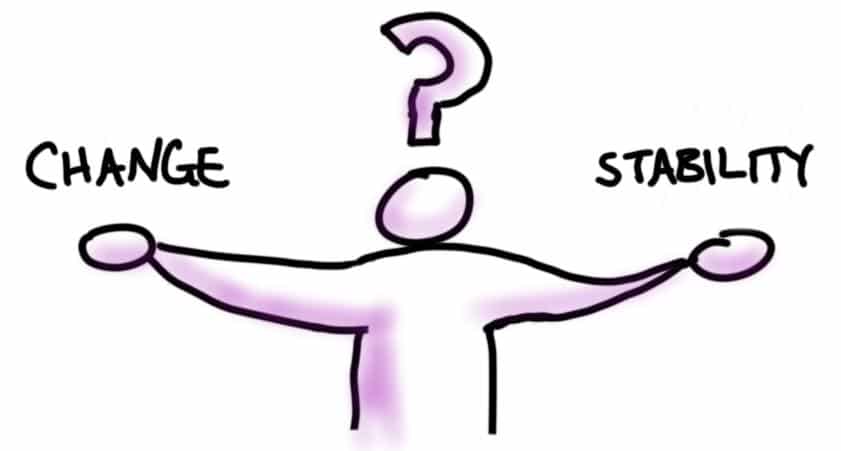Balancing your process with Takt time
Weathering the Storm of IT Change – balancing your process with Takt time
In a previous blog post I covered the IT Service Management and Lean IT concepts of Change Management and Takt time. In linking Change and Takt, I concluded that World Class IT mandates a Change Management process that keeps up to Takt Time.
Easier said than done of course – in fact as mentioned in the previous post, successful Change Management is delicate and often times overwhelmed by the storm of IT change. How do we maintain balance? Utilizing Lean IT and IT Service Management/ITIL methodology, let’s look at five suggestions that can help.

Five suggestions for balancing Change and Takt
1. Pick the pillars
My foremost suggestion to customers struggling with change management is to establish a limited definition of what changes they intend to manage with their change process. Usually we try to control too many changes. Pick instead the change pillars, the most important IT pieces that hold your delivery together and manage these.

2. Visually map your Change Management process
Keep it short and sweet and make your map visual. Use my 5 steps to change (see previous post) or a similar variation, but don’t drown in huge diagrams and swim lanes here. What do we do in the process, who does it, how and in what order?

Visualize the process in your mind or on paper as a conveyor belt, moving from left to right and at the far right dropping one successful change at a time into the arms of the customer. Or better yet, use Kanban boards or (my personal favorite) Change Walls to display your change flow in a large, visual format.
3. Start counting and timing
Working from your visual map, get out your counters and stopwatches. (And stay simple, avoid dreary details.)
- What period of time will we measure – one day, one week, one month?
- How many changes to the pillars are we managing during that period of time?
- What is the average change time for one single change from input to output?
Again, here we can visualize the conveyor belt carrying changes – how fast is it moving? Use your visual map or Change Wall to track the process. Count the RFCs, tickets, projects or post-its. Strive to break down changes into similar sizes/complexities (i.e don’t compare a logistics project to delivery of a workstation). Count the tickets, days and minutes and take note.
As our visual map, counters and stopwatches report back to us, we should be able to build a good feel and estimate for our lead time from start to finish. What is our current change speed? How long does it take us to manage a successful change?

4. What is the target pace?
Step 3 determines our current speed – now in step 4 we need to compare that to the speed of customer demand. Remember that Takt Time is that demand, the pace of change they expect us to keep. What is that pace?
Measuring demand can be challenging. Keeping to our simplicity, count the number of changes the customer has requested in the given period. Practically, the measurement here is performed similarly to the previous step. The difference is determining if there is unfinished work., i.e. change the customer expects us to have performed at a pace beyond our current speed.
Once we grasp the volume and pace of the customer’s demand, compare it to your speed. Is this pace fast enough to meet customer demand, i.e. Takt Time? If we are managing successful change, then we should find little unfinished work and/or negative consequences to our changes. But more than likely, when we compare change speed to Takt Time, we’ll find discrepancies. These become our areas of improvement for step 5.
5. Identify improvement opportunities
As we map and count and time, patterns will emerge. In our final step, we stand before our visual board and take out a big red pen. With it, we start circling opportunities. More than likely, we will see a process that is flowing faster in some areas and slower in others. Look for and circle:
- Bottlenecks and queues – these areas signify waiting in our process, probably due to limited capacity.
- Recurring errors or difficulties – another waste in our process, we want change without incidents.
- Inventories – are we creating too much change in an area where resources could be redistributed elsewhere?
- Transaction-intensive change – can we simplify?
Circling areas of waste provides us with improvement opportunities. Bottlenecks can be addressed with multiple lanes/options at that point in the process. Finding root causes to errors can eliminate wasted time and resources. Minimizing inventory gives us the opportunity to redistribute resources elsewhere. Too many transactions challenge us to simplify.
Results from the Five Suggestions
In my work with IT leaders, I am told time and again that understanding and aligning IT to Takt Time is extremely difficult. And they’re right. In the short-term, change pace can vary greatly – from all focus on one huge project to a sudden flurry of 55 “normal” changes. And in the long-term the Takt time of IT Change is steadily increasing.

Yet obviously we cannot give up. Our responsibility to our customers is to deliver World Class IT – robust, competitive IT services that sustainably deliver value over time. This includes a robust and measured Change Management in alignment with customer demand.
Smart and simple application of Lean IT and IT Service Management methodology can help. Through working the five suggestions above, we should have developed a better understanding of our Change Management process, the customers Takt Time expectations, and areas for improvement.
These suggestions above borrow from concepts such as Voice of Customer, SIPOC diagrams, Value Stream Mapping, Kanban and Kaizen. These methods are tried and true, but not rocket science. To learn more, look up our course Lean IT Foundation. But most importantly get started!
Lean for IT
Lean for IT lär dig hur du använder och tillämpar IT management-principer för ett bättre flöde i leveranser med reducerat svinn.
När är ledarskapet det största hindret till flöde?
I vår strävan efter högre effektivitet, snabbare leveranser och bättre flöde är det lätt att förbise en avgörande faktor: ledarskapet. Ibland är det just vi som leder som skapar de största hindren för flöde och värdeskapande.
Kartläggning av värdeflöden
Att förstå hur arbetet faktiskt flyter genom organisationen från idé till kund är avgörande för att lyckas med förbättringar. Här berättar vi hur en värdeflödeskartläggning kan hjälpa dig till effektivare flöden, engagerade team och ökad kundnöjdhet.

